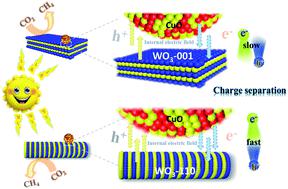当前位置:
X-MOL 学术
›
Sustain. Energy Fuels
›
论文详情
Our official English website, www.x-mol.net, welcomes your
feedback! (Note: you will need to create a separate account there.)
A 1D/2D WO3 nanostructure coupled with a nanoparticulate CuO cocatalyst for enhancing solar-driven CO2 photoreduction: the impact of the crystal facet
Sustainable Energy & Fuels ( IF 5.0 ) Pub Date : 2020-03-23 , DOI: 10.1039/d0se00034e Mengmeng Zhang 1, 2, 3, 4, 5 , Kai Zhao 5, 6, 7, 8 , Jinyan Xiong 9, 10, 11, 12, 13 , Yi Wei 1, 2, 3, 4, 5 , Chao Han 14, 15, 16, 17 , Weijie Li 14, 15, 16, 17 , Gang Cheng 1, 2, 3, 4, 5
Sustainable Energy & Fuels ( IF 5.0 ) Pub Date : 2020-03-23 , DOI: 10.1039/d0se00034e Mengmeng Zhang 1, 2, 3, 4, 5 , Kai Zhao 5, 6, 7, 8 , Jinyan Xiong 9, 10, 11, 12, 13 , Yi Wei 1, 2, 3, 4, 5 , Chao Han 14, 15, 16, 17 , Weijie Li 14, 15, 16, 17 , Gang Cheng 1, 2, 3, 4, 5
Affiliation

|
Photocatalytic reduction of CO2 into solar fuels is regarded as one of the most promising approaches to address the issues of global warming and the energy crisis. The promotion of spatial charge separation and transfer through crystal facet engineering could be conducive to improved photocatalytic activity. In this study, one-dimensional (1D) WO3 nanowires with a {110} dominant facet (WO3-110) and two-dimensional (2D) WO3 nanosheets with a {001} dominant facet (WO3-001) coupled with CuO nanoparticles are fabricated by a facile method and used for CO2 photoreduction. Its composition and structural characterizations suggest that the WO3–CuO hybrid features good contact between the WO3 and CuO nanostructures. Under light irradiation, the WO3 and WO3–CuO nanostructures are able to photoreduce CO2 into CH4. Notably, the prepared WO3–CuO nanohybrids with different exposed facets show improved CO2 reduction capability compared to pure WO3 and CuO. The heterojunction interface between the WO3 photocatalyst and the CuO cocatalyst through p–n contact can facilitate electron–hole pair separation and accordingly results in enhanced photocatalytic performance. With the assistance of the CuO cocatalyst, the {110} facet WO3–CuO hybrid displays superior photoreduction capability compared to the {001} facet WO3–CuO, which is attributed to the difference in the crystal facets in the heterostructure. The {110} facet WO3 nanowires have a more negative conduction band edge, contributing to the higher reduction capacity of this sample. On the other hand, it is shown that faster charge carrier transfer efficiency would enable more photoinduced electrons to participate in CO2 photoreduction, especially with the involvement of the nanoparticulate CuO cocatalyst. This work provides guidance for designing a hetero-photocatalyst–cocatalyst system through crystal facet engineering.
中文翻译:

一维/ 2维WO3纳米结构与纳米颗粒CuO助催化剂的结合,可增强太阳能驱动的CO2光还原:晶面的影响
将CO 2光催化还原为太阳能燃料被认为是解决全球变暖和能源危机问题的最有前途的方法之一。通过晶体刻面工程促进空间电荷的分离和转移可能有助于改善光催化活性。在这项研究中,具有{110}主刻面(WO 3 -110)的一维(1D)WO 3纳米线和具有{001}主刻面(WO 3 -001)的二维(2D)WO 3纳米片用方便的方法制备CuO纳米颗粒并用于CO 2光还原。其组成和结构特征表明WO 3–CuO杂化物具有WO 3和CuO纳米结构之间的良好接触。在光照射下,WO 3和WO 3 -CuO纳米结构能够将CO 2光还原为CH 4。值得注意的是,与纯WO 3和CuO相比,制备的具有不同暴露面的WO 3 -CuO纳米杂化物显示出更高的CO 2还原能力。通过p–n接触,WO 3光催化剂和CuO助催化剂之间的异质结界面可以促进电子-空穴对的分离,从而提高光催化性能。在CuO助催化剂的协助下,{110}面WO 3与{001}晶面WO 3 -CuO相比,–CuO杂化物显示出优异的光还原能力,这归因于异质结构中晶面的差异。{110}刻面WO 3纳米线的负导带边缘更大,从而有助于该样品的更高还原能力。另一方面,表明更快的电荷载流子转移效率将使得更多的光诱导电子能够参与CO 2的光还原,特别是在纳米颗粒CuO助催化剂的参与下。这项工作为通过晶面工程设计杂化光催化剂-助催化剂系统提供了指导。
更新日期:2020-03-23
中文翻译:

一维/ 2维WO3纳米结构与纳米颗粒CuO助催化剂的结合,可增强太阳能驱动的CO2光还原:晶面的影响
将CO 2光催化还原为太阳能燃料被认为是解决全球变暖和能源危机问题的最有前途的方法之一。通过晶体刻面工程促进空间电荷的分离和转移可能有助于改善光催化活性。在这项研究中,具有{110}主刻面(WO 3 -110)的一维(1D)WO 3纳米线和具有{001}主刻面(WO 3 -001)的二维(2D)WO 3纳米片用方便的方法制备CuO纳米颗粒并用于CO 2光还原。其组成和结构特征表明WO 3–CuO杂化物具有WO 3和CuO纳米结构之间的良好接触。在光照射下,WO 3和WO 3 -CuO纳米结构能够将CO 2光还原为CH 4。值得注意的是,与纯WO 3和CuO相比,制备的具有不同暴露面的WO 3 -CuO纳米杂化物显示出更高的CO 2还原能力。通过p–n接触,WO 3光催化剂和CuO助催化剂之间的异质结界面可以促进电子-空穴对的分离,从而提高光催化性能。在CuO助催化剂的协助下,{110}面WO 3与{001}晶面WO 3 -CuO相比,–CuO杂化物显示出优异的光还原能力,这归因于异质结构中晶面的差异。{110}刻面WO 3纳米线的负导带边缘更大,从而有助于该样品的更高还原能力。另一方面,表明更快的电荷载流子转移效率将使得更多的光诱导电子能够参与CO 2的光还原,特别是在纳米颗粒CuO助催化剂的参与下。这项工作为通过晶面工程设计杂化光催化剂-助催化剂系统提供了指导。











































 京公网安备 11010802027423号
京公网安备 11010802027423号